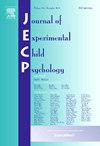Finger use mirroring young children’s ways of experiencing numbers
IF 1.8
2区 心理学
Q3 PSYCHOLOGY, DEVELOPMENTAL
引用次数: 0
Abstract
Children who encounter questions about quantities or numbers are observed to use their fingers in different ways to aid their problem solving. This study aimed to contribute to the area of finger counting research with an inquiry of what children’s finger use tells us about their knowledge of numbers. A basic argument is that it is not sufficient to observe the actual use of fingers; there is a need for interpretations of what the finger use means to the children, taking the children’s perspective as the outset. This was done by analyzing 4- and 5-year-olds’ finger use through the lens of phenomenography and variation theory of learning to describe the qualitatively different ways in which children use fingers as an expression of their ways of experiencing the meanings of numbers. Five categories of finger use that show a variety in the meanings the fingers represent emerged: Fingers represent individual items, quantities, countables, number relations, and number structure. The results show that children’s finger use may give access to their ways of understanding numbers; some ways of using fingers indicate expressions of more or less advanced meanings of numbers. A conclusion from the results is that to develop number knowledge and skills, children are aided by learning to see and use their fingers as representing composed units. Some children need the structural support of fingers to solve number problems, and fingers should be used to explore number structures rather than used as countables.
手指的使用反映了幼儿体验数字的方式。
据观察,儿童在遇到有关数量或数字的问题时,会以不同的方式使用手指来帮助解决问题。本研究旨在通过探究儿童使用手指的情况来了解他们对数字的认识,从而为手指计数研究领域做出贡献。一个基本论点是,仅仅观察手指的实际使用情况是不够的;还需要从儿童的角度出发,解释手指的使用对儿童意味着什么。为此,我们从现象学和学习变异理论的角度分析了 4 岁和 5 岁儿童使用手指的情况,描述了儿童使用手指的不同方式,以此表达他们体验数字含义的方式。结果发现,手指的使用有五种类型,分别代表不同的意义:手指分别代表单个物品、数量、可数名词、数字关系和数字结构。结果表明,儿童使用手指的方式可以让人了解他们理解数字的方式;使用手指的某些方 式表明他们表达了或多或少的数字高级含义。研究结果得出的结论是,要发展数字知识和技能,儿童应学会把手指看作是组成单位并加以使用。有些幼儿需要手指的结构支持来解决数字问题,手指应被用来探索数字结构,而不是用作计数器。
本文章由计算机程序翻译,如有差异,请以英文原文为准。
求助全文
约1分钟内获得全文
求助全文
来源期刊

Journal of Experimental Child Psychology
Multiple-
CiteScore
4.50
自引率
7.70%
发文量
190
期刊介绍:
The Journal of Experimental Child Psychology is an excellent source of information concerning all aspects of the development of children. It includes empirical psychological research on cognitive, social/emotional, and physical development. In addition, the journal periodically publishes Special Topic issues.
 求助内容:
求助内容: 应助结果提醒方式:
应助结果提醒方式:


